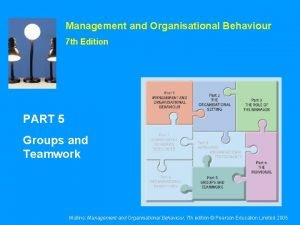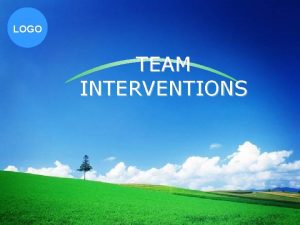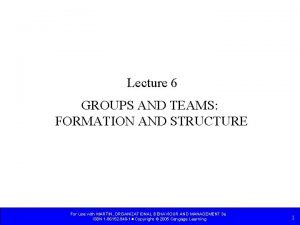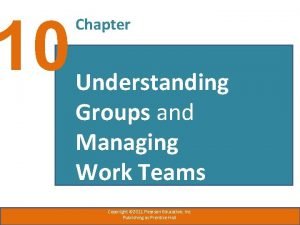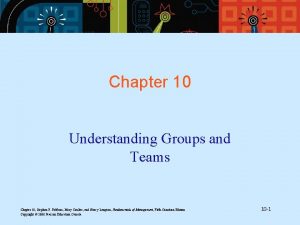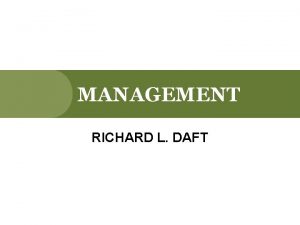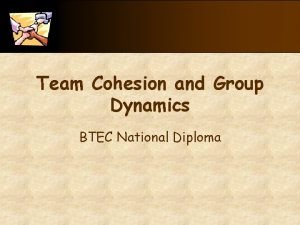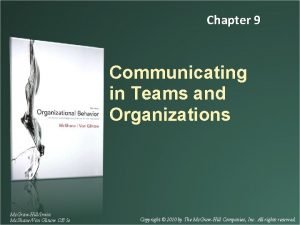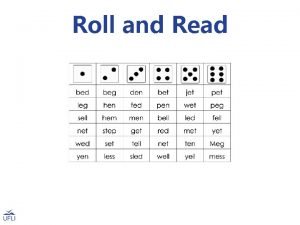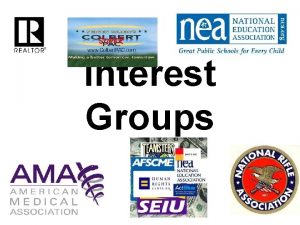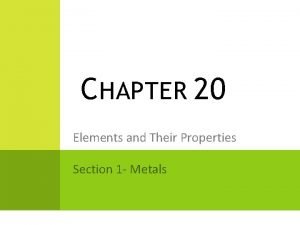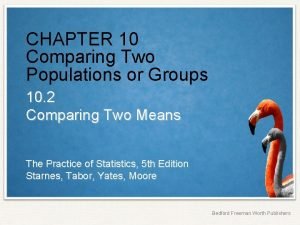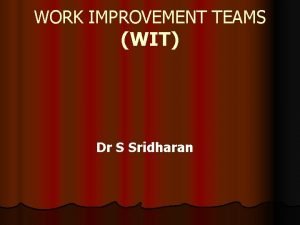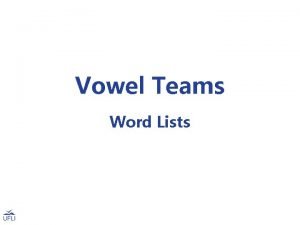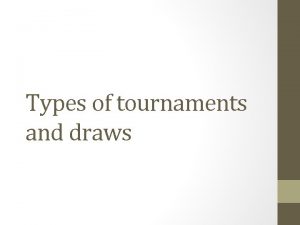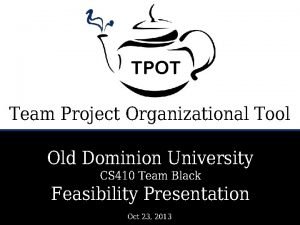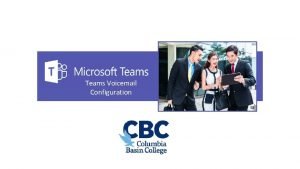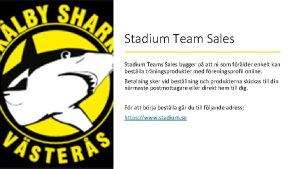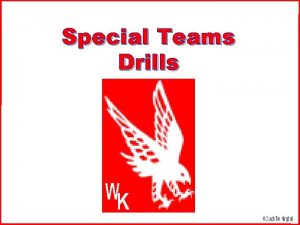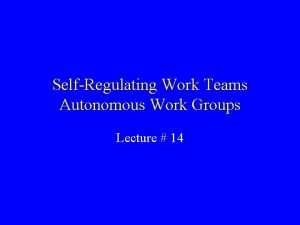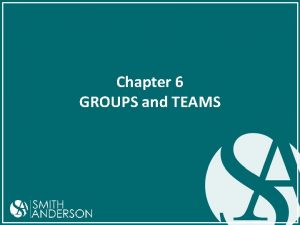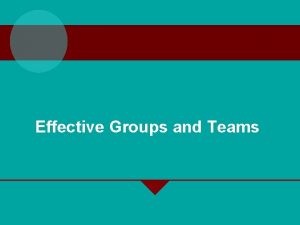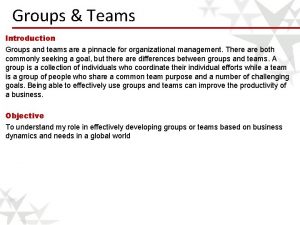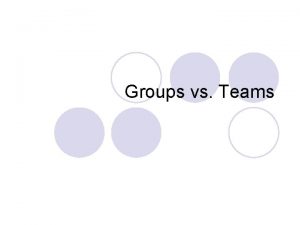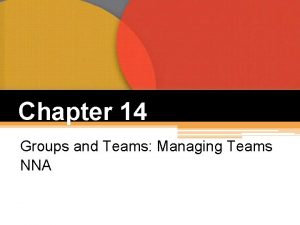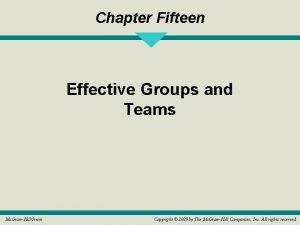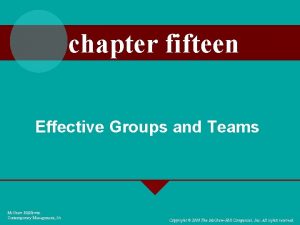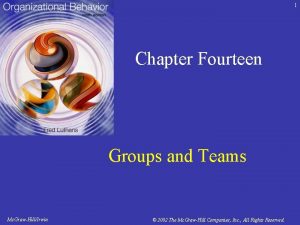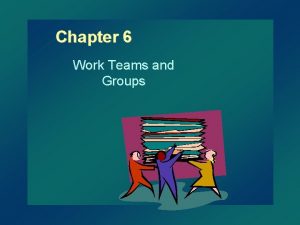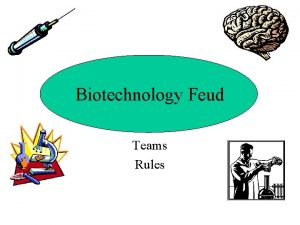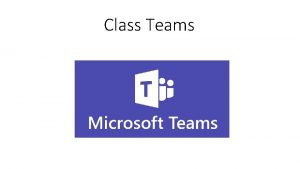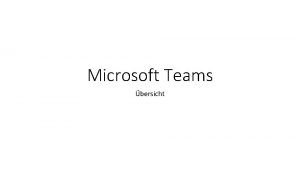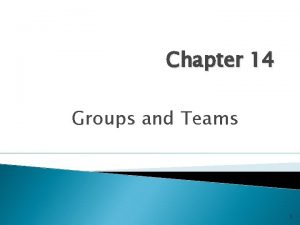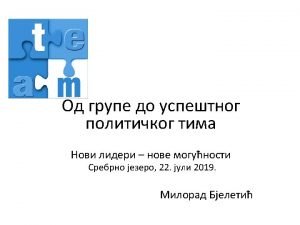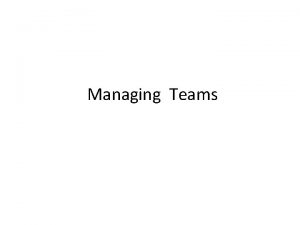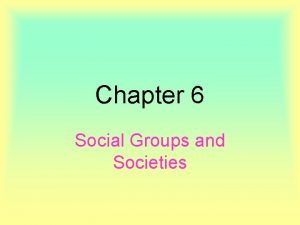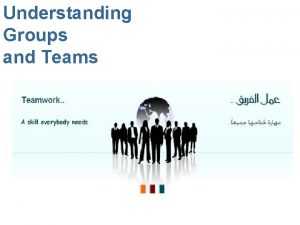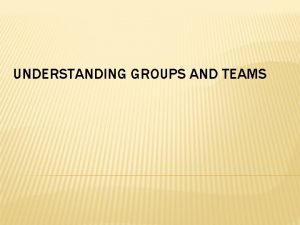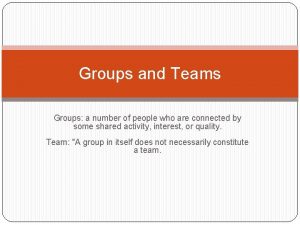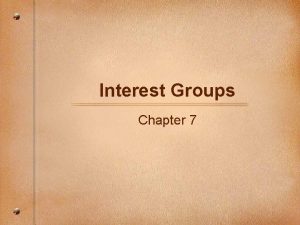Chapter 10 Groups and Teams Mc GrawHillIrwin Copyright


































- Slides: 34

Chapter 10 Groups and Teams Mc. Graw-Hill/Irwin Copyright © 2014 by The Mc. Graw-Hill Companies, Inc. All rights reserved.

Learning Objectives n Summarize the model of group formation and development n Compare the differences between formal and informal groups n Understand the reasons why people form groups n Explain the five stages of group formation n Describe the major characteristics of groups n Discuss relevant criteria for group effectiveness n Differentiate between the different types of teams 10 -2

Introduction The existence of groups can alter a person’s motivation or needs and can influence the behavior of people in an organizational setting 10 -3

Introduction Groups and Teams are Not the Same • Group… two or more individuals interacting with each other to accomplish a common goal • Team… mature group with member inter-dependence and motivation to achieve a common goal Teams start out as groups, but not all groups mature into teams 10 -4

EXHIBIT 10. 1 Comparison of Groups and Teams 10 -5

The Nature of Groups Minimum requirements for a group to exist Two or more individuals A common goal to be accomplished Some form of exchange or communication between these individuals 10 -6

EXHIBIT 10. 2 A Model of Group Formation and Development 10 -7

Types of Groups Command Formal Groups Task Team Interest Informal Groups Friendship 10 -8

Exhibit 10. 3 Five Reasons Why People Form Groups 10 -9

Stages of Group Development Forming • Group forms and situation is uncertain and disorganized Storming • Turbulence, disruption, and frustration is at highest level Norming • Share vision, values, goals, and expectations; deviations are not welcome Performing • Roles are specific, goals are clear, and results are noted Adjourning • Orderly disbanding 10 -10

Group Composition n Members of a homogeneous group share a number of characteristics ■ n Members of a heterogeneous group have few or no similar characteristics All else being equal, homogeneous groups are the most likely to be cohesive ■ Heterogeneous groups can outperform homogeneous ones because they have a richer variety of knowledge and experience 10 -11

Group Status Hierarchy Status is typically a consequence of characteristics that differentiate one position from another • A person is sometimes given status because of job seniority, age, or assignment • Assigned status may have nothing to do with the formal status hierarchy The status hierarchy can have unintended and undesirable effects on preference • Subordinates may be reluctant to challenge those in charge, even when necessary 10 -12

Group Member Roles Expected Role Enacted Role Perceived Role 10 -13

Group Norms are standards shared by group members • Formed only with respect to things that have significance for the group • May be communicated in writing or verbally • Accepted in various degrees by group members • Used to regulate member behavior • May apply to all members, or only some 10 -14

Norm Conformity n Why employees conform to group norms is an issue of concern to managers n Variables which influence conformity ■ ■ Personal characteristics of the individual Situational factors Inter-group relationships Cultural factors 10 -15

EXHIBIT 10. 4 Hypothetical Production Norm and Its Zone of Acceptance 10 -16

Group Leadership n Leaders exert influence over members ■ n In formal groups, leaders can reward or punish members who do not conform to orders or rules A formal group may have no formal leader ■ ■ Autonomous work groups Self-managed teams 10 -17

Group Leadership An informal group leader generally is a respected and high-status member who • Embodies the values of the group • Helps the group accomplish its goals • Enables members to satisfy needs The leader receives and interprets communication relevant to the group 10 -18

Group Cohesiveness n A closeness or commonness of attitude, behavior, and performance ■ ■ n Acts on the members to remain in a group Is greater than the forces pulling members away from the group As the cohesiveness of a work group increases, conformity to group norms also increases ■ These norms may not be consistent with those of the organization 10 -19

Group Cohesiveness n Sources of group attraction ■ Goals of the group and members are compatible ■ A charismatic leader A good reputation for accomplishing tasks The group is small enough to permit members of have their opinions heard Members support and help one another ■ ■ ■ 10 -20

EXHIBIT 10. 5 The Relationship between Group Cohesiveness and Organizational Goals 10 -21

To Increase Group Cohesion Reach joint agreement on group goals Make the group more homogeneous Increase interaction among group members Make the group smaller Physically or socially isolate the group Allocate rewards to the group, not individuals Give the group and members more responsibility 10 -22

Groupthink n The deterioration of mental efficiency, reality testing, and moral judgment in the interest of group solidarity 10 -23

Groupthink n Characteristics of groups suffering from groupthink ■ ■ ■ Illusion of invulnerability Tendency to moralize Feeling of unanimity Pressure to conform Opposing ideas dismissed 10 -24

End Results n Measurable production is not the only end result of work group activities ■ ■ ■ The group’s productive output meets the standard of quantity, quality, and timeliness of the users of the output The group process of doing the work enhances the capability of group members to work together interdependently in the future The group experience contributes to the growth and well-being of its members 10 -25

Teams n The difference between a team and an immature, developing group ■ n Total commitment to common goals and accountability to the team Perceived gains from using teams… ■ ■ ■ Economic improvements Quality and productivity gains Flattening of the organizational structure 10 -26

Types of Teams Problem. Solving Self. Managed Team Categories R&D Cross. Functional Virtual 10 -27

Team Effectiveness Empowerment Training Effectiveness Rewards Communications 10 -28

Training n Team training includes ■ Individual task-related skills and abilities ■ How to function as a team member Problem-solving skills Creative thinking Interpersonal skills ■ ■ ■ 10 -29

Improving Member Effectiveness n Skills to improve team member effectiveness ■ ■ ■ ■ Open-mindedness Emotional stability Accountability Problem-solving abilities Communication skills Conflict resolution skills Trust 10 -30

Communications Teams often require information that used to be management’s exclusive domain Managers often fear a loss of their decisionmaking power Many teams fail due to management’s unwillingness to share information with the teams it created 10 -31

Empowerment n Regardless of the type of team, those that lack authority are less effective ■ ■ n It suggests that management doesn’t trust the team It is the root of team empowerment problems Teams can also be given too much authority ■ Particularly true during the early stages of team development ■ Training can help members use authority effectively 10 -32

Rewards n Most rewards systems are individual-based ■ ■ To the extent that teams perform well, the team should be rewarded Reward systems can be incentive based or a form of profit-sharing 10 -33

In Review, Did We… n Summarize the model of group formation and development n Compare the differences between formal and informal groups n Understand the reasons why people form groups n Explain the five stages of group formation n Describe the major characteristics of groups n Discuss relevant criteria for group effectiveness n Differentiate between the different types of teams 10 -34
 What is the difference between team and group
What is the difference between team and group Groups and teams difference
Groups and teams difference Groups and teams difference
Groups and teams difference Understanding groups and managing work teams
Understanding groups and managing work teams Understanding groups and teams
Understanding groups and teams Understanding groups and teams
Understanding groups and teams How are ethnic groups and religious groups related
How are ethnic groups and religious groups related Chapter 10 motivating and satisfying employees and teams
Chapter 10 motivating and satisfying employees and teams Chapter 10 motivating and satisfying employees and teams
Chapter 10 motivating and satisfying employees and teams Motivating and satisfying employees and teams
Motivating and satisfying employees and teams Motivating and satisfying employees and teams
Motivating and satisfying employees and teams Copyright
Copyright Steiner's model of group effectiveness
Steiner's model of group effectiveness Peopleware definition
Peopleware definition Persuasive communication
Persuasive communication Leading and working in teams
Leading and working in teams Or roll and read
Or roll and read New deal affects many groups
New deal affects many groups Chapter 9 section 3 interest groups at work
Chapter 9 section 3 interest groups at work Chapter 10 comparing two populations or groups crossword
Chapter 10 comparing two populations or groups crossword Chapter 9 section 2 types of interest groups
Chapter 9 section 2 types of interest groups Chapter 17 section 3 mixed groups
Chapter 17 section 3 mixed groups Chapter 10 comparing two populations or groups
Chapter 10 comparing two populations or groups Work improvement teams
Work improvement teams Vowel teams word list
Vowel teams word list Unity teams tutorial
Unity teams tutorial What is a ladder tournament
What is a ladder tournament Tpot teams
Tpot teams How to set up voicemail on teams
How to set up voicemail on teams Teams around the family
Teams around the family Teams stadium
Teams stadium Sphere shield microsoft teams
Sphere shield microsoft teams Special teams drills
Special teams drills Autonomous work groups
Autonomous work groups Virtual teams are often slowed down by difficulty with
Virtual teams are often slowed down by difficulty with
